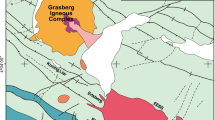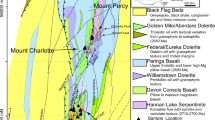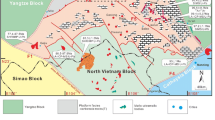Abstract
Hydrothermal sulfide–oxide–gold mineral assemblages in gold deposits in the Archaean St. Ives gold camp in Western Australia indicate extremely variable redox conditions during hydrothermal alteration and gold mineralization in space and time. Reduced alteration assemblages (pyrrhotite–pyrite) occur in deposits in the southwest of the camp (e.g., Argo, Junction deposits) and moderately to strongly oxidized assemblages (magnetite–pyrite, hematite–pyrite) occur in deposits in the Central Corridor in the northeast (e.g., North Orchin, Revenge deposits). Reduced mineral assemblages flank the Central Corridor of oxidized deposits and, locally, cut across it along E–W trending faults. Oxidized mineral assemblages in the Central Corridor are focused on gravity lows which are interpreted to reflect abundant felsic porphyritic intrusions at about 1,000 m below present surface. Hydrothermal magnetite predates and is synchronous with early phases of gold-associated albite–carbonate–pyrite–biotite–chlorite hydrothermal alteration. Later-stage, gold-associated pyrite is in equilibrium with hematite. The spatial distribution and temporal sequence of iron sulfides and oxides with gold indicate the presence of at least two spatially restricted but broadly synchronous hydrothermal fluids with contrasting redox states. Sulfur isotope constraints support the argument that the different mineral assemblages reflect differences in redox conditions. The δ 34S values for pyrite for the St. Ives gold camp range between −8.4‰ and +5.1‰ with the negative values occurring in oxidized magnetite-rich domains and slightly negative or positive values occurring in reduced, pyrrhotitic domains. Preliminary spatial and paragenetic analysis of the distribution of iron sulfides and oxides in the St. Ives camp suggests that gold grades are highest where the redox state of the hydrothermal alteration assemblages switches from relatively reduced pyrrhotite–pyrite to relatively oxidized magnetite–pyrite and hematite–pyrite both in space and time. Gold deposition is inferred to have occurred where fluids of contrasting redox state mixed.





Similar content being viewed by others
References
Clark ME, Carmichael DM, Hodgson CJ, Fu M (1989) Wall-rock alteration, Victory Gold Mine, Kambalda, Western Australia: processes and P-T-X(CO2) conditions of metasomatism. In: Keays RR, Ramsay WRH, Groves DI (eds) The geology of gold deposits: the perspective in 1988. Economic Geology Monograph 6, pp 445–456
Clout JMF (1989) Structural and isotopic studies of the Golden Mile gold-telluride deposit, Kalgoorlie, Western Australia. Ph.D. thesis, Monash University
Cox SF, Ruming K (2004) The St. Ives mesothermal gold system, Western Australia—a case of golden aftershocks. J Struct Geol 26:1109–1125
Groves DI (1993) The crustal continuum model for late Archean lode-gold deposits of the Yilgarn Block, Western Australia. Miner Depos 28:36–374
Groves DI, Goldfarb RJ, Robert F, Hart CJR (2003) Gold deposits in metamorphic belts: Overview of current understanding, outstanding problems, future research, and exploration significance. Econ Geol 98:1–29
Hagemann SG, Cassidy KF (2000) Archaean orogenic gold deposits. Rev Econ Geol 13:9–68
Hagemann SG, Cassidy KF (2001) World-class gold camps and deposits in the Eastern Goldfields Province, Yilgarn Craton: diversity in host rocks, structural controls, and mineralization styles. In: Hagemann, SG, Neumayr, P, Witt, WK (eds) World-class gold camps and deposits in the Eastern Yilgarn Craton Western Australia, with special emphasis on the Eastern Goldfields Province: Geological Survey of Western Australia, vol 2001/17. pp 7–44
Ho SE, Bennett JM, Cassidy KF, Hronsky JMA, Mikucki EJ, Sang JH (1990) Fluid inclusion studies. In: Ho, SE, Groves, DI, Bennett, JM (eds) Gold deposits of the Archaean Yilgarn Block, Western Australia: Nature, genesis and exploration guides: Geology Department and University Extension The University of Western Australia, Publication 20, pp 198–211
Hodkiewicz P (2003) The interplay between physical and chemical processes in the formation of world-class orogenic gold deposits in the Eastern Goldfields Province, Western Australia. Ph.D. thesis, The University of Western Australia
Marsh S (1988) Origin of the magnetite-rich facies Kapai Slate, Kambalda, Western Australia. Honours thesis, The University of Western Australia
McCuaig TC, Kerrich R (1998) P-T-t-deformation-fluid characteristics of lode gold deposits: evidence from alteration systematics. Ore Geol Rev 12:381–453
Neumayr P, Cabri LJ, Groves DI, Mikucki EJ, Jackman JA (1993) The mineralogical distribution of gold and relative timing of gold mineralization in two Archean settings of high metamorphic grade in Australia. Can Mineral 31:711–725
Neumayr P, Hagemann SG, Walshe J, Morrison RS (2003) Camp- to deposit-scale zonation of hydrothermal alteration in the St. Ives gold camp, Yilgarn Craton, Western Australia: evidence for two fluid systems? In Mineral Exploration and Sustainable Development, Seventh Biennial SGA Meeting, Athens, pp 799–802
Neumayr P, Hagemann SG, Horn L, Walshe J, Morrison RS (2004a) Camp- to deposit-scale spatial zonation and temporal succession of redox indicator sulfide-oxide minerals; vectors to Archaean orogenic gold deposits; an example from the St. Ives gold camp, Yilgarn Craton, Western Australia. In 17th Australian Geological Convention, Hobart, Tasmania, Australia, pp 105
Neumayr P, Hagemann SG, Walshe J, Horn L (2004b) Sulphide-oxide mineral relationships on camp to deposit scale: vectors to orogenic gold deposits? In SEG 2004 Predictive Mineral Discovery Under Cover, Perth, Australia, pp 450
Neumayr P, Petersen KJ, Gauthier L, Hodge JL, Hagemann SG, Walshe JL, Prendergast K, Connors K, Horn L, Frikken P, Roache A, Blewett RS (2005) Mapping of hydrothermal alteration and geochemical gradients as a tool for conceptual targeting: St. Ives Gold Camp, Western Australia. In Meeting the Global Challenge, 8th Biennial SGA meeting, Beijing, pp 1479–1482
Nguyen PT, Cox SF, Harris LB, Powell CM (1998a) Fault-valve behaviour in optimally oriented shear zones: an example at the Revenge gold mine, Kambalda, Western Australia. J Struct Geol 20:1625–1640
Nguyen PT, Cox SF, Harris LB, Powell CM (1998b) Fault-valve behaviour in optimally oriented shear zones: an example at the Revenge gold mine, Kambalda, Western Australia. J Struct Geol 20:1625–1640
Petersen KJ, Neumayr P, Hagemann SG, Walshe JL (2005) Palehydrologic evolution of the Kambalda gold camp. In: Bierlein FP, Mao J (eds) Mineral Deposit Research: Meeting the Global Challenge. Springer, Berlin, Heidelberg, New York, pp 573–576
Polito PA, Bone Y, Clarke JDA, Mernagh TP (2001) Compositional zoning of fluid inclusions in the Archaean Junction gold deposit, Western Australia: a process of fluid–wall–rock interaction. Aust J Earth Sci 48:833–855
Swager CP, Griffin TJ, Witt WK, Wyche S, Ahmat AL, Hunter WM, McGoldrick, PJ (1995) Geology of the Archean Kalgoorlie Terrane—an explanatory note (reprint of Record 1990/12): Perth, Geological Survey of Western Australia, 33
Walshe JL, Halley SW, Hall GA, Kitto P (2003) Contrasting fluid systems, chemical gradients and controls on large-tonnage, high-grade Au deposits, Eastern Goldfields Province, Yilgarn Craton, Western Australia. In Mineral Exploration and Sustainable Development, 7th Biennial SGA meeting, Athens, pp 827–830
Walshe JL, Neumayr P, Petersen K, Halley S, Roache A, Young, C (2006) Scale-integrated, architectural and geodynamic controls on alteration and geochemistry of gold systems in the Eastern Goldfields Province, Yilgarn Craton, Project M358. Minerals and Energy Research Institute of Western Australia, Report No. 256, p 200
Watchorn RB (1998) Kambalda-St. Ives gold deposits. In: Berkman DA, Mackenzi DH (eds) Geology of Australian and Papua New Guinean mineral deposits. The Australasian Institute of Mining and Metallurgy, Melbourne, pp 243–254
Acknowledgements
This work forms part of MERIWA 358/377 and pmd*CRC Y3 and Y4 projects. The work on St. Ives gold camp is financially supported by St. Ives Gold Mining Company (Pty) Limited, and the authors wish to acknowledge their financial support and permission to present the data and interpretations. Current and former staff of St. Ives Gold Mining Company (Pty) Limited, most notably Ned Stolz, Janet Tunjic, Bob Morrison, Karen Connors, James Johnson, and Ed Ainscough are thanked for their support and countless discussions. The enthusiastic support of Greg Hall, formerly Chief Geologist of Placer Dome Ltd, for the development of conceptual exploration strategies is acknowledged.
Author information
Authors and Affiliations
Corresponding author
Additional information
Editorial handling: Adrian Boyce
Rights and permissions
About this article
Cite this article
Neumayr, P., Walshe, J., Hagemann, S. et al. Oxidized and reduced mineral assemblages in greenstone belt rocks of the St. Ives gold camp, Western Australia: vectors to high-grade ore bodies in Archaean gold deposits?. Miner Deposita 43, 363–371 (2008). https://doi.org/10.1007/s00126-007-0170-2
Received:
Accepted:
Published:
Issue Date:
DOI: https://doi.org/10.1007/s00126-007-0170-2




